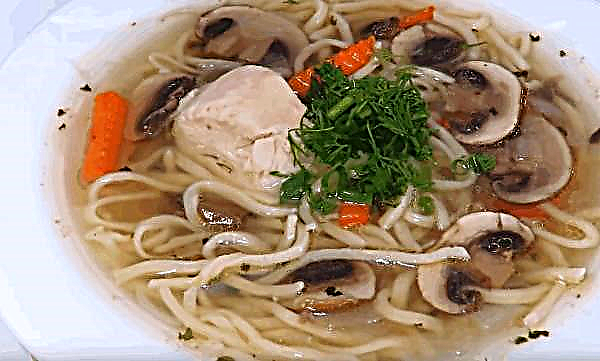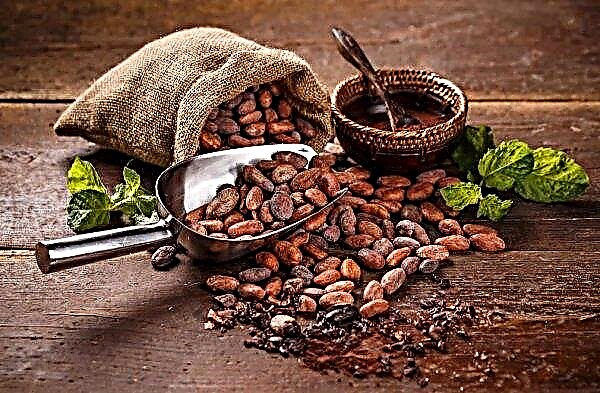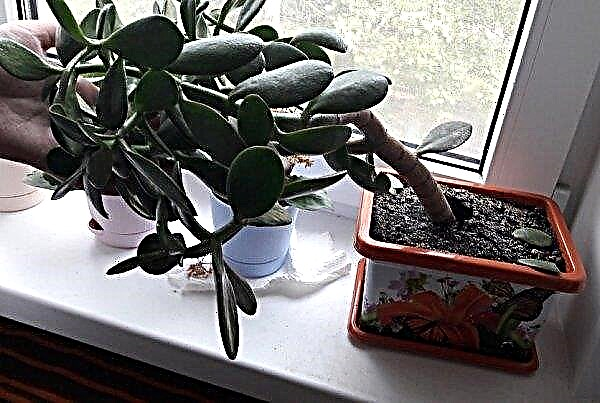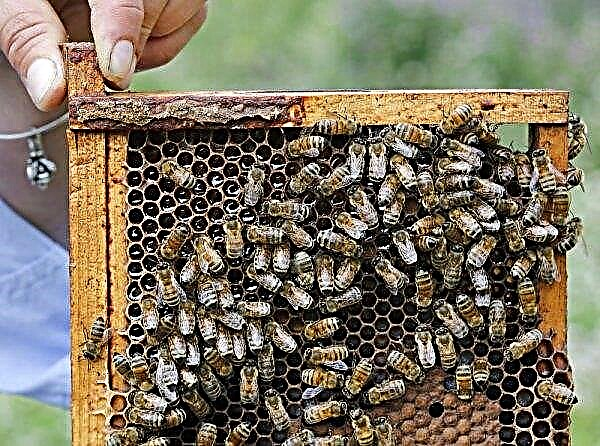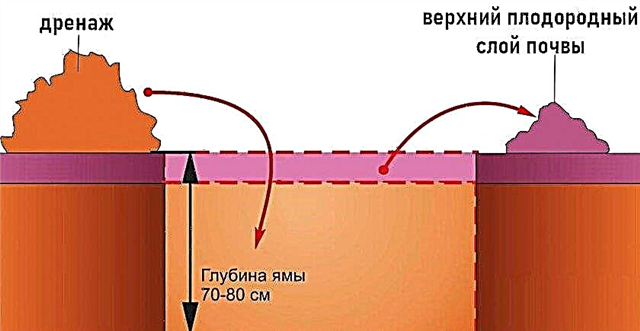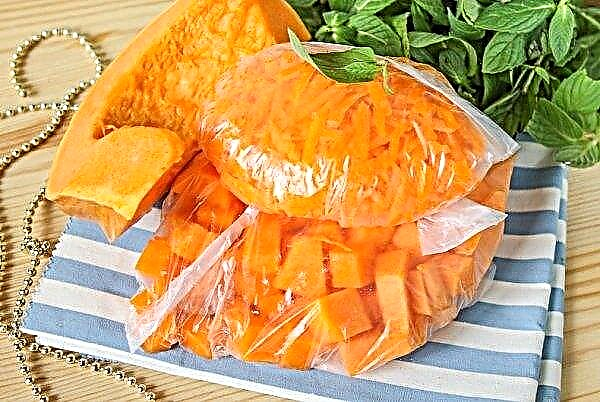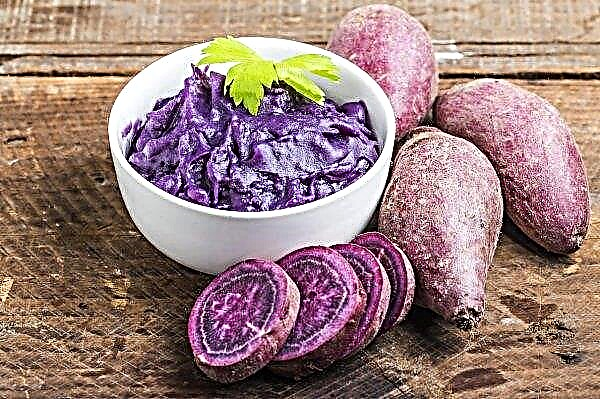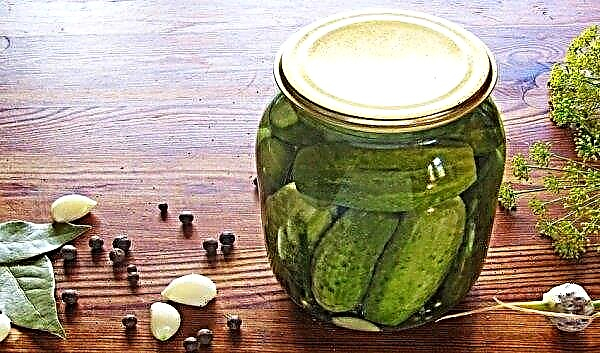Buckwheat cultivation volumes have fallen in recent years, which has led to an inevitable jump in prices for the processed product. Replenishing the emerging deficit in modern conditions requires not only an extensive increase in sown areas, but also the most competent approach to production - sowing, harvesting and processing buckwheat, the details of which will be discussed below.
Buckwheat sowing dates
A novice farmer needs to know that in the agricultural technology of growing buckwheat, the correctly selected planting period is so important that it depends almost 90% on how much the crop will be harvested from the buckwheat field.
The fact is that the plant in question can be severely affected by both spring return frosts and severe drought, which overtook sprouts during the period of active flowering and fruit formation. Therefore, it is very important to determine the optimal time period that will protect the culture from both of these risks.Did you know? Buckwheat is one of the best honey plants among annual herbaceous plants. From one hectare of a field sown with a crop, you can get up to 100 kg of high-quality honey.
A clear calendar date for the duration of buckwheat sowing cannot be called, since they depend on three factors of equal importance:
- climate zone;
- a specific variety of the crop to be sown (including the timing of their ripening - the more mature the plant, the sooner it should be planted);
- type of soil and topography (the heavier the soil, the less the sowing depth, and, consequently, the earth will warm up faster to the required temperature level);
- current weather conditions (the last moment every year gains more and more weight, as the climate is changing rapidly).

It is necessary to focus primarily on the depth of soil warming. For most varieties of seed buckwheat, it is necessary that the temperature at a depth of 8–10 cm be at least + 8ºС (some varieties need even warmer conditions, for them you need to add another 1-2 degrees to the specified parameter).
Important! Tetraploid buckwheat varieties are sown earlier than determinant ones. Diploid varieties of culture, for example, Zhniyarka or Anita Belorusskaya, are least dependent on the successfully selected planting period.
Adjusted for all these nuances and features, we can say that in the middle zone of the European part of Russia, the sowing period of buckwheat can last about a month - from May 10 to early June.
Buckwheat desiccation
Proper agricultural techniques of buckwheat cultivation requires the mandatory implementation of such a specific event as desiccation. It consists in the processing of crops with special preparations, with the aim of forcibly drying the grain (the word "desiccation" from the Latin word for word can be translated as "drying").

- The procedure allows you to achieve several important goals at once, namely:
- accelerate the ripening process;
- block weed overgrowth of the field;
- prevent the spread of pests, fungal infections and other diseases that often affect crops in the last stages of their development (the positive effect applies not only to the plants themselves, but also to the area on which they grew, thus, it is possible to significantly save the cost of carrying out preventive tillage with various pesticides );
- facilitate the collection process, reduce the percentage of unavoidable losses;
- reduce the drying time of grains;
- facilitate subsequent cleaning of the nucleus;
- extend shelf life.
It is possible to process crops with desiccators even in rainy weather, although a greater effect is achieved if the procedure is carried out on a dry field.
Important! Desiccation is a modern agricultural technique that allows increasing the amount of harvested crops by 40% and higher, however, it is incompatible with organic farming, since it involves the processing of grain with chemical preparations.
An unpleasant feature of buckwheat for the farmer is that this culture has the ability to ripen very unevenly: the process of forming grains can stretch from three weeks to a month and a half. Thus, objectively, one has to face the fact that when harvesting, some part of the nucleus on the same plant is unripe, and the other, on the contrary, is overripe.
 To reduce losses, the so-called “separate combining” method was previously used, which involves collecting buckwheat in two stages: first, the technique mowed the plants and left them on the ground to dry for several days, and only after that the harvest was carried out.
To reduce losses, the so-called “separate combining” method was previously used, which involves collecting buckwheat in two stages: first, the technique mowed the plants and left them on the ground to dry for several days, and only after that the harvest was carried out.
For the sale of buckwheat under the label “organic product”, separate combining is still the only acceptable method of collecting crops, in addition, cereals that have passed preliminary desiccation can not formally be used in baby food. Precisely because, without desiccation, crop losses increase significantly, organic buckwheat is more expensive than “ordinary”.
Did you know? Buckwheat yield rarely exceeds 1 ton per hectare, which is 6 times less than rice productivity and 8 times less than millet. However, taking into account the cost of first-class kernel, the buckwheat growing business can be twice as profitable.
The current level of technology allows the use of many desiccation methods, including those aimed at super-frequency radiation. But most often all the same we are talking about the chemical treatment of substances related to hazardous or moderately hazardous. In this case, the immediate risk is not so much the consumer as the specialists working with the drug in the field. Nevertheless, it is not worth discounting a potential health hazard, especially since not only buckwheat is subjected to the “chemical drying” procedure, but also other traditional crops on our table - potatoes, sunflowers, flax, soybeans, sugar beets, peas, beans and etc.

Among the drugs used for desiccation of buckwheat, it is worth mentioning:
- Regalon;
- "Registan";
- Dikvalan;
- "Heat BT";
- "Squar";
- Alpha Diquat
- Euston;
- "Scorpio";
- "Leaf fall";
- "Boxing ring";
- Golden
- "BP";
- calcium chlorate (3%);
- continuous herbicides (pesticides used to treat fields against weeds) - one of the most dangerous for the environment options.
 The procedure should be carried out approximately 6-10 days before the planned harvest.
The procedure should be carried out approximately 6-10 days before the planned harvest.
When buckwheat is taken from the fields
Taking into account the already mentioned irregularity and delayed ripening, it is sometimes very difficult for a farmer, especially a beginner, to determine when it is possible to start harvesting buckwheat. For the right choice, a certain clue may be the weather. The fact is that during a drought, when the air humidity is less than 40%, the grain mass ceases to increase, and it makes no sense to keep crops on the field longer.
In wet weather, the ripening period, on the contrary, is delayed, however, even after the long-awaited rain falls, the stopped process of crop formation can resume, but only if the aboveground part of the plant (stem and leaves) did not have time to completely dry. But even in this situation, each subsequent flowering of the repairing buckwheat gives an increasingly insignificant increase in the yield, while the previously ripened fruits (they usually form on the lower tiers of the stem) crumble and, thus, become inaccessible for harvesting.

A sign that the time to harvest is steadily approaching is the change in the color of buckwheat stems from green to brown. Fully ripened grains have the same shade. But if the weather is wet, the plant continues to bloom and turn green, you need to go through the field and carefully look at the condition of the crops, trying to find the “golden mean” that will allow you to collect the maximum amount of ripened grain and minimize losses from the crumbled or, on the contrary, unripened crop .
According to generally accepted practice, to start collecting it is necessary that the plant had at least 67–75% of the darkened grains. This percentage can only be determined manually. To do this, cut several stems of buckwheat in different parts of the field, remove the seeds from them, sort them into two parts — ripened and unripeened — and, after calculating the number of fruits in each group, calculate their ratio (proportion).Important! Harvesting buckwheat in the wet summer is necessary when the volume of ripened grains becomes more significant than the number of new buds, flowers and underdeveloped fruits.
 As in the case of determining the time for sowing, it is impossible to give recommendations on the exact calendar dates. Approximately for the middle zone of the European part of the Russian Federation, buckwheat harvesting begins in August, less often in September.
As in the case of determining the time for sowing, it is impossible to give recommendations on the exact calendar dates. Approximately for the middle zone of the European part of the Russian Federation, buckwheat harvesting begins in August, less often in September.
How to collect buckwheat
The method of harvesting buckwheat is determined by the biological characteristics of the culture.
The basic rules are as follows:
- it is important to carry out the procedure in a short time - no more than five days;
- if the weather is dry, it is recommended to work in the morning or evening hours (at this time, the stems of plants are wetter and more elastic, which protects them from breaking off and reduces the percentage of shedding of the nucleus);
- the optimum height of the cut of the stem is 15–20 cm, in which case buckwheat does not fall to the ground, which reduces losses from shedding;
- for work it is necessary to use special agricultural equipment - combines with drum or conveyor pickups designed for harvesting cereal plants (Don, John Deere, etc.), as well as mounted headers, such as ZhNS-6-12 or ZhVN-6A , or trailed ZhVS-6 or ZhRS-4.9A (if the fields are heavily clogged, as well as when lodging crops, the ZhSK-4A or ZhRB-4.2 type reapers are more preferable);
- when setting up the header, you must strive to ensure that during mowing the plant mass comes into contact with the reel strips only once (for this, the peripheral speed should exceed the translational speed by about 1.2–1.43 times).
 Experienced farmers are also well aware that new agricultural machinery should not be used to harvest tender and capricious buckwheat, since the factory sharp edges of the working bodies of such combines can disrupt the integrity of the kernel.
Experienced farmers are also well aware that new agricultural machinery should not be used to harvest tender and capricious buckwheat, since the factory sharp edges of the working bodies of such combines can disrupt the integrity of the kernel.
Buckwheat harvesting methods
If buckwheat is not grown on an industrial scale, but within a small private plot, the crop can also be harvested using an ordinary scythe. The host collects the mowed plants in small sheaves, which should lie down in the open air for about 24 hours. Then, sheaves are formed from sheaves. In this form, the stems finally dry up, after which they are crushed by hand, holding each plant over a clean bag and using a wooden stick, shaking off the fruits.
However, modern technology involves the use of two professional methods of harvesting buckwheat from the fields - the already mentioned separate combining (two-phase) and direct (single-phase). The choice of method depends on the condition of crops, weather conditions and, to a certain extent, the farmer's personal preferences.

The main characteristics of each of the above methods are shown in the table:
| Index | Direct combine | Separate Combining |
| Grain Aging Degree | up to 90% (danger of overload) | 80% and below |
| Cultivars for which the method is preferred | Diploid and fine-grained | Tetraploid, coarse-grained determinant, seed (used for subsequent sowing) |
| State of crops | Stunted, sparse, damaged by disease or frost | Actively blooming, moist and dense |
Thus, direct combine harvesting is a necessary measure used in cases where there is a real threat of mass loss of crops. This method yields a notoriously low result regarding cereal quality. At the same time, the crop is harder to process and clean, because the buckwheat stems remain moist, and they have to be separated from the green weeds.
Important! The optimum moisture content of buckwheat grains for threshing is 18%, but for leaves and stems it should be higher - about 30–35%.
In a separate method, the mowed crops are collected in rolls and left on the field. After 3-4 days, the moisture content of the grain decreases from the initial 55% by about three times, after which the buckwheat is crushed by the drum of a combine harvester installed at a low rotation speed (about 500-700 rpm). If you leave the rolls on the field longer, the fruits dry out and crumble, which should never be allowed. Separate combine harvesting not only reduces crop losses, but also significantly reduces costs during subsequent processing.

Buckwheat processing after harvest
Processing harvested grain is a complex and multi-stage process. At the same time, cereal is subjected to the following procedures:
- cleaning - removal of impurities, dirt, damaged grains, carried out by means of a separator, trimmer or stone separation machine;
- hydrothermal treatment, assuming three consecutive phases - steaming, drying and cooling, as a result of which the croup acquires strength, which facilitates further work with it;
- peeling - removal of the upper layer from fruits, consisting of substances that are not digestible by the human body and are not suitable for human consumption;
- sorting - preliminary, for coarse and fine grains, and final, in fractions;
- grinding - grinding and giving the groats the correct shape and smooth structure, resulting in reduced time for heat treatment of the finished product;
- packaging and preparation for sale.
 In order for the finished buckwheat groats to fully meet modern standards according to criteria such as taste, smell, purity, structure and boiling factor, its processing requires expensive equipment and a special laboratory equipped with various measuring instruments.
In order for the finished buckwheat groats to fully meet modern standards according to criteria such as taste, smell, purity, structure and boiling factor, its processing requires expensive equipment and a special laboratory equipped with various measuring instruments.
The specific process used to process buckwheat depends on which product is expected to be obtained from the collected grain.
Did you know? In addition to the “Smolensk groats”, the term “Sorochinsky millet” is found in old cookbooks. This rice culture was called “Saracen” in the French manner, so the word “Sorochinsky” in this case is not related to the famous Poltava fair.
There may be five options:
- unground buckwheat - whole grains, peeled from the fruit coat;
- done - grains, the integrity of which was not completely managed to be preserved during processing (relatively speaking, buckwheat of the second grade);
- the so-called "Smolensk groats" - an outdated term applied to buckwheat of the third grade, which has much more destroyed grains than whole grains;
- brown groats - core, subjected to additional heat treatment;
- buckwheat flour - the grinding can be made both from the selected core, and from the "Smolensk" groats, depending on this, the grade of finished flour is determined.

According to the approved standards, buckwheat groats of the first, second and third grades must meet such quality characteristics:
- the minimum percentage of high-quality grain - from 99.2% for the first grade and up to 98.3% for the second and third;
- the maximum percentage of crushed grains - from 3% for the first and up to 4% for the second and third;
- the maximum percentage of unrefined grains is from 0.3% for the first and up to 0.4% for the second and third.
How to store collected buckwheat
Despite the long and complicated post-harvest processing, the shelf life of high-quality buckwheat is very short. This is largely due to the very rich chemical composition of the product and the many beneficial properties that it possesses. After the expiration of time, the croup, although it continues to remain edible, does not grow moldy and does not even become bitter in taste, but still loses its nutritional value and, in fact, turns into "empty" carbohydrates.

As a general rule, raw buckwheat - both brown and green - should be consumed within a year after packaging.
This period can be extended approximately twice if you create ideal conditions for the product:
- protection from light;
- cool temperature (for example, in the refrigerator);
- sealed packaging (in the form of a glass jar with a rubber lid that prevents moisture from getting inside).
After boiling, the product should be stored only in the refrigerator, and this period should not exceed 72 hours. The same rule applies to sprouted green buckwheat. In order to prevent the dish from spoiling, it should not contain any additives - milk, butter or meat with gravy in porridge can be put immediately before serving.Did you know? The protein contained in buckwheat is absorbed by the body by almost 80%. Compared to other cultures, this indicator is an absolute record.

Theoretically prepared porridge can be frozen. Many chefs claim that in this way they manage to save the product for 2-3 weeks, then to use it, for example, for making pancakes or buckwheat cutlets. But you should not put raw groats in the freezer; at low temperatures, the initial qualities of the kernel do not change for the better.
Sowing buckwheat - a capricious culture, because its cultivation is associated with a number of difficulties. At the same time, in terms of yield indicators, this plant is seriously inferior to its main competitors. However, the high price of the finished product and its rich vitamin and mineral composition makes buckwheat cultivation a profitable occupation not only for large agricultural companies, but also for small farms.


